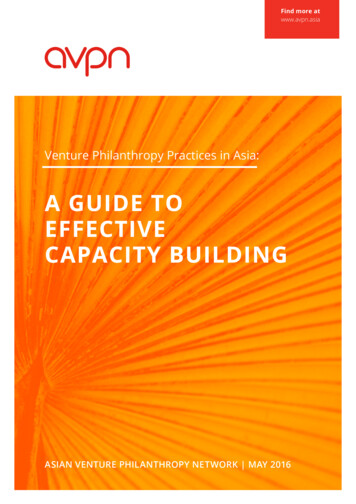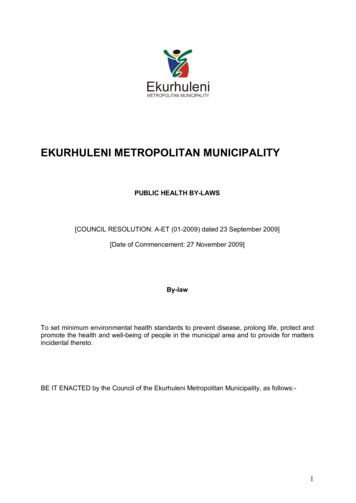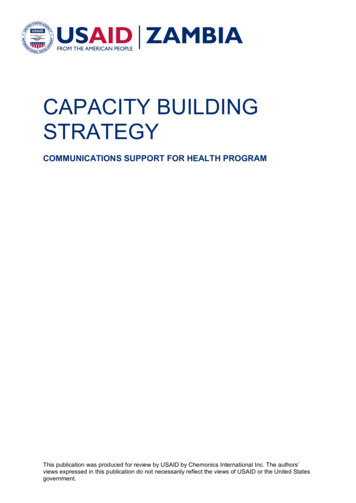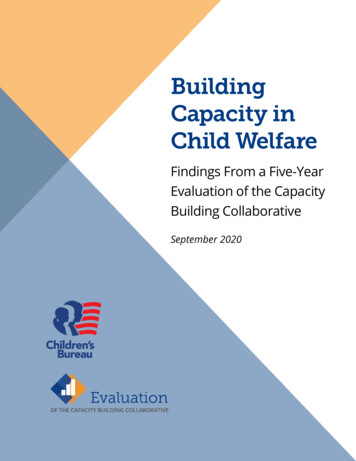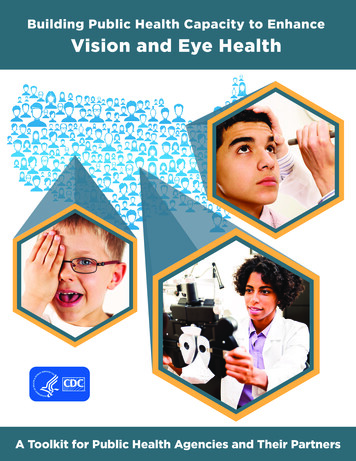
Transcription
Building Public Health Capacity to EnhanceVision and Eye HealthA Toolkit for Public Health Agencies and Their Partners
All materials are available for download on the CDC website at ggested CitationCenters for Disease Control and Prevention. Building Public Health Capacity to Enhance Vision and Eye Health: AToolkit for Public Health Agencies and Their Partners. Atlanta, GA: Centers for Disease Control and Prevention, USDept. of Health and Human Services: 2019.Website addresses of nonfederal organizations are provided solely as a service to readers. Provision of anaddress does not constitute an endorsement of this organization by CDC or the federal government, and noneshould be inferred. CDC is not responsible for the content of other organizations’ Web pages.
AcknowlegementsLEAD WRITERSThis document was written by the following people, in collaboration with KDH Research & Communication:Jinan B. Saaddine, MD, MPHSwathi Sekar, MPHCenters for Disease Control and PreventionFormerly at the Centers for Disease Control and PreventionParamjit K. Sandhu, MD, MPHCarol McPhillips-Tangum, MPHCenters for Disease Control and PreventionNational Association of Chronic Disease DirectorsCONTRIBUTORSThe following people contributed their subject matter expertise to the development, editing, and/or review ofthis document:Kira BaldonadoM. Isabel Mendez, MSPrevent BlindnessCenters for Disease Control and PreventionBetsy CagleMarcus J. Molea, AICP, MHAAlabama Department of HealthOhio Department of Aging (Retired)Clarice ConleyCourtney MurphyCenters for Disease Control and PreventionPrevent Blindness WisconsinAmanda CrowellHeather PatrickCenters for Disease Control and PreventionPrevent Blindness TexasMonica GuerreroMichael SmithPrevent Blindness TexasAlabama Department of HealthSusan LeonardDean A. VanNasdale, PhDCenters for Disease Control and PreventionThe Ohio State UniversityElizabeth Lundeen, PhD, MPH, MNSPChristina WilliamsCenters for Disease Control and PreventionCenters for Disease Control and PreventionChristopher Maylahn, MPHCenters for Disease Control and PreventionThis publication was supported by the Grant or Cooperative Agreement Number 5NU38OT000286-01, fundedby the Centers for Disease Control and Prevention. Its contents are solely the responsibility of the authorsand do not necessarily represent the official views of the Centers for Disease Control and Prevention or theDepartment of Health and Human Services.i
ContentsIntroduction . . . . . . . . . . . . . . . . . . . . . . . . . . . . . . . . . . . . . . . . . . . . . 1Vision Impairment in the United States . . . . . . . . . . . . . . . . . . . . . . . . . . . . . . . . . . . . 1. . . . . . . . . . . . . . . . . . . . . . . . . . . . . . . . . . . . . . 2How to Use This Toolkit . . . . . . . . . . . . . . . . . . . . . . . . . . . . . . . . . . . . . . . . . . 2References . . . . . . . . . . . . . . . . . . . . . . . . . . . . . . . . . . . . . . . . . . . . . .3Public Health Agencies Can HelpSection 1: Assess Vision and Eye Health in Your Community . . . . . . . . . . . . . . . . . . . . . 4Tips for Collecting and Using Assessment Data . . . . . . . . . . . . . . . . . . . . . . . . . . . . . . . . 5Additional Resources . . . . . . . . . . . . . . . . . . . . . . . . . . . . . . . . . . . . . . . . . . . 9Conclusion . . . . . . . . . . . . . . . . . . . . . . . . . . . . . . . . . . . . . . . . . . . . . .9From the Field: Using Data to Create Fact Sheets That Show a Picture of the Problem . . . . . . . . . . . . . . . . . . 10References . . . . . . . . . . . . . . . . . . . . . . . . . . . . . . . . . . . . . . . . . . . . . . 11Section 2: Build Effective Partnerships . . . . . . . . . . . . . . . . . . . . . . . . . . . . . . . 12Identify Potential Partners . . . . . . . . . . . . . . . . . . . . . . . . . . . . . . . . . . . . . . . . . . . . . . . . . . . . . . . . . . . .13Formalize the Partnership . . . . . . . . . . . . . . . . . . . . . . . . . . . . . . . . . . . . . . . . 15Sustain the Partnership . . . . . . . . . . . . . . . . . . . . . . . . . . . . . . . . . . . . . . . . . 15Conclusion. . . . . . . . . . . . . . . . . . . . . . . . . . . . . . . . . . . . . . . . . . . . . .16From the Field: Building Partnerships to Enhance Vision and Eye Health . . . . . . . . . . . . . . . . . . . . . . . 17References . . . . . . . . . . . . . . . . . . . . . . . . . . . . . . . . . . . . . . . . . . . . .18Section 3: Implement Interventions to Improve Vision and Eye Health . . . . . . . . . . . . . . . 19. . . . . . . . . . . . . . . . . . . . . . . . . . . . . . . . . . . . . . . . . . . . . . . . . . . . . . . . . . . .Interventions to Promote Awareness of Vision and Eye Health Issues . . . . . . . . . . . . . . . . . . . . . . . .Interventions to Promote Access to Vision and Eye Care for Populations at Risk . . . . . . . . . . . . . . . . . . . .Interventions to Promote Rehabilitation and Improve Quality of Life for People With Vision Impairment and Eye Disorders . . . . .Conclusion . . . . . . . . . . . . . . . . . . . . . . . . . . . . . . . . . . . . . . . . . . . . . .From the Field: Integrating Vision and Eye Health Into a Team-Based Care Approach for Diabetes . . . . . . . . . . . . . .References . . . . . . . . . . . . . . . . . . . . . . . . . . . . . . . . . . . . . . . . . . . . . .Things to Consider Before Implementing an Intervention19Examples of Vision and Eye Health Interventions20Section 4: Evaluate the Impact of Vision-Related Interventions . . . . . . . . . . . . . . . . . .The Importance of an Evaluation Plan . . . . . . . . . . . . . . . . . . . . . . . . . . . . . . . . . . . .Things to Consider Before Starting an Evaluation . . . . . . . . . . . . . . . . . . . . . . . . . . . . . . . .Program Evaluation in Six Steps . . . . . . . . . . . . . . . . . . . . . . . . . . . . . . . . . . . . . .Applying the Six Steps to Vision and Eye Health Interventions . . . . . . . . . . . . . . . . . . . . . . . . . . .Conclusion . . . . . . . . . . . . . . . . . . . . . . . . . . . . . . . . . . . . . . . . . . . . . .From the Field: Using Evaluation Results to Answer the “So What?” Question . . . . . . . . . . . . . . . . . . . . . .Additional Online Resources . . . . . . . . . . . . . . . . . . . . . . . . . . . . . . . . . . . . . . .References . . . . . . . . . . . . . . . . . . . . . . . . . . . . . . . . . . . . . . . . . . . . . .202123242526272728283233343536Appendix A. Behavioral Risk Factor Surveillance System Vision Health Questions . . . . . . . . . 37Appendix B. Tools . . . . . . . . . . . . . . . . . . . . . . . . . . . . . . . . . . . . . . . . . 38Checklist for Developing a PartnershipPartnership Assessment ToolPartnership Communication WorksheetEvaluation Plan ChecklistLogic Model Templateii
INTRODUCTIONVision health is critically important for all aspects of a person’s life, including physical health, social engagement,education, employment, and socioeconomic position. Reduced vision affects a person’s ability to perform dailyactivities and increases a person’s risk of other health problems and premature death.1–5 It can also cause economicstress on individuals and society from direct medical expenses and indirect expenses related to loss of mobility andproductivity. In the United States (US), direct and indirect expenses for eye disorders across all age groups were about 139 billion in 2013.6Unfortunately, vision health is rarely included in public health programs designed to prevent or manage chronicdiseases because of limited resources and competing priorities. As a result, most public health agencies lack theframework or guidelines they need to appropriately address vision and eye health as a public health issue.Building Public Health Capacity to Enhance Vision and Eye Health: A Toolkit for Public Health Agencies and Their Partners,developed by the Centers for Disease Control and Prevention (CDC), can help state, tribal, local, and territorialpublic health agencies and their partners assess the level of vision impairment in their communities, build effectivepartnerships, and implement effective and sustainable interventions to improve vision and eye health.VISION IMPAIRMENT IN THE UNITED STATESIn 2015, about 3 million people aged 40 or older in the United States had vision impairment and 1 million were blind.More than 8 million people had vision impairment caused by an uncorrected refractive error, such as nearsightednessor astigmatism. These numbers are expected to double by 2050 because of the aging US population and theprojected increase in chronic diseases, such as diabetes.7 An estimated 2.1 million children and adults younger thanage 40 have an uncorrectable vision impairment or blindness.8Studies have consistently shown that loss of vision is one of the greatest healthfears that people have.9 The leading causes of blindness and vision impairmentare primarily age-related eye diseases, such as diabetic retinopathy, age-relatedmacular degeneration, cataract, and glaucoma. More than 30 million adults aged40 or older are affected by age-related eye diseases. More than 7 million adultsare affected by diabetic retinopathy, which is the leading cause of new cases ofblindness in working age adults.10For information aboutcommon causes of visionimpairment and eyedisorders, visit the CDC’sVision Health Initiative(VHI) Common EyeDisorders website.Early diagnosis and timely treatment can often correct vision impairment andslow the progression of some conditions. Many interventions exist to help peoplewith vision impairment, but information about and access to these services areoften limited.11,12Vision and Eye Health: A Toolkit for Public Health Agencies and Their Partners1
PUBLIC HEALTH AGENCIES CAN HELPVision impairment and blindness are a public health problem because they: Affect the lives of a large number of people. Cause a large amount of disease, disability, and economic burden and reduce quality of life. Are predicted to get worse in the next 30 years. Are perceived by the public to be a threat. Can be addressed through community or population-level interventions.13Coordinated efforts by public health agencies and partners are needed to encourage policies and programs that: Emphasize the importance of preserving vision and eye health. Reduce modifiable risk factors. Improve timely detection, treatment, and management of vision impairment and eye disorders.Potential partners in these efforts include clinical care systems, government agencies, education agencies,communities, employers and businesses, state agencies on aging or disabilities, foundations, and nonprofitorganizations.HOW TO USE THIS TOOLKITPublic health agencies and their partners can use the information in this toolkit to improve vision and eye health intheir community. Four actions are recommended and described in the following sections.1Assess visionand eye health inyour community3Implementinterventions toimprove vision andeye health2Build effectivepartnerships4Evaluate theimpact of visionrelated interventionsEach section also contains a narrative, called “From the Field,” that describes how public health practitioners areworking to promote vision and eye health at state or local levels. These practitioners offer practical suggestions basedon their experiences.Vision and Eye Health: A Toolkit for Public Health Agencies and Their Partners2
REFERENCES1. Alberti CF, Peli E, Bowers AR. Driving with hemianopia: III. Detection of stationary and approachingpedestrians in a simulator. Invest Ophthalmol Vis Sci. 2014;55(1):368–374.2. Sengupta S, van Landingham SW, Solomon SD, Do DV, Friedman DS, Ramulu PY. Driving habits in olderpatients with central vision loss. Ophthalmol. 2014;121(3):727–732.3. Brown JC, Goldstein JE, Chan TL, Massof R, Ramulu P. Low Vision Research Network Study GroupCharacterizing functional complaints in patients seeking outpatient low-vision services in the United States.Ophthalmol. 2014;121(8):1655–1662, e1651.4. Whitson HE, Cousins SW, Burchett BM, Hybels CF, Pieper CF, Cohen HJ. The combined effect of visualimpairment and cognitive impairment on disability in older people. J Am Geriatr Soc. 2007;55(6):885–891.5. Whitson HE, Malhotra R, Chan A, Matchar DB, Ostbye T. Comorbid visual and cognitive impairment:relationship with disability status and self-rated health among older Singaporeans. Asia Pac J Public Health.2014;26(3):310–319.6. Wittenborn J, Rein D. Cost of Vision Problems: The Economic Burden of Vision Loss and Eye Disorders in theUnited States. Chicago, IL: NORC at the University of Chicago; 2013.7. Wittenborn J, Rein D. The preventable burden of untreated eye disorders. Paper prepared for theNational Academy of Science, Engineering, and Medicine. isordersCommissionedPaper.pdf. Accessed October 28, 2019.8. Varma R, Vajaranant TS, Burkemper B, et al. Visual impairment and blindness in adults in the United States:demographic and geographic variations from 2015 to 2050. JAMA Ophthalmol. 2016;134(7):802–809.9. Scott AW, Bressler NM, Folkes S, Wittenborn JS, Jorkasky J. Public attitudes about eye and vision health. JAMAOphthalmol. 2016;134(10):1111–1118.10. National Eye Institute. Prevalence of Adult Vision Impairment and Age-Related Eye Diseases in Americawebsite. https://nei.nih.gov/eyedata/adultvision usa. Accessed October 28, 2019.11. Overbury O, Wittich W. Barriers to low vision rehabilitation: the Montreal Barriers Study. 2011. InvestOphthalmol Vis Sci. 2012;52(12):8933–8938.12. Pollard TL, Simpson JA, Lamoureux EL, Keefe JE. Barriers to accessing low vision services. Ophthalmic PhysiolOpt. 2003;23(4):321–327.13. Centers for Disease Control and Prevention. Vision Health Initiative x.htm. Accessed March 29, 2016.Vision and Eye Health: A Toolkit for Public Health Agencies and Their Partners3
SECTION 1:ASSESS VISION AND EYEHEALTH IN YOUR COMMUNITYBefore you create a plan to implement and evaluate a public health intervention to improve vision and eye health, youmust assess your community’s needs. This assessment will help you understand: How many people in your community have The characteristics of the people most The prevalence of risk factors, such as The extent to which people in yourvision impairment and eye disorders.diabetes, that put people at higher risk ofvision disorders.affected by vision impairment and eyedisorders.community have access to vision services andeye care providers and use these services.Collecting this information will help you choose interventions, allocate resources, monitor vision impairment and eyedisorders, and evaluate your progress in meeting the needs of your community.1ASSESMENT DATA CAN ALSO HELP YOU:7 Identify people with vision impairment and those at risk of an eye disorder.7 Estimate the magnitude and scope of vision impairment and associated health problems.7 Measure trends and monitor changes in vision and eye health status.7 Identify disparities in access to eye care and the geographic distribution of populations athigh-risk.7 Prioritize interventions to address gaps and issues related to vision and eye health.7 Plan, implement, and guide the evaluation of vision and eye health interventions.7 Develop hypotheses and stimulate research.7 Educate stakeholders about the importance of developing and implementing evidencebased and cost-effective vision and eye health interventions.7 Allocate resources to promote vision and eye health.Vision and Eye Health: A Toolkit for Public Health Agencies and Their Partners4
TIPS FOR COLLECTING AND USING ASSESSMENT DATA1. Explore Existing Surveillance SystemsThe federal government conducts several ongoing health-related surveys to collect vision and eye health information.For example, the Vision and Eye Health Surveillance System (VEHSS) collects data from national and state surveys,examination-based studies, electronic health records and registries, and administrative databases (e.g., Medicare,private medical insurance). This information helps health professionals, researchers, policymakers, and membersof the public understand the scope of vision loss, eye disorders, and eye careservices across the United States. The VEHSS was developed by CDC’s VisionHealth Initiative and the non-partisan and objective research organizationNORC at the University of Chicago. More information about the system’s datasources is available on the VEHSS website. The following are some of thenational and state surveys included in the VEHSS: The American Community Survey (ACS) is an annual, nationallyrepresentative survey conducted by the US Census Bureau. It collectsand produces information on demographic, social, economic, andhousing characteristics of the US population. Include data from theVision and Eye HealthSurveillance System whenyou assess the health needsof your community andcreate a community healthimprovement plan. Thisinformation will help youmake vision and eye health apublic health priority.The Behavioral Risk Factors Surveillance System (BRFSS) is an annualhealth-related telephone survey conducted by CDC’s National Center for Chronic Disease Preventionand Health Promotion. It collects state-level data about US residents regarding their health-related riskbehaviors, chronic health conditions, and preventive services use. The National Health Interview Survey (NHIS) is an annual household interview survey of thenoninstitutionalized US population conducted by CDC’s National Center for Health Statistics (NCHS). Itcollects data on a broad range of health topics. The National Health and Nutrition Examination Survey (NHANES) is an annual self-report and examinationsurvey conducted by CDC’s NCHS. It collects information on the health and nutritional status of US adultsand children. The National Survey of Children’s Health (NSCH) is an annual survey conducted by the Health Resources andServices Administration’s Maternal and Child Health Bureau. It collects data on the physical and emotionalhealth of US children from birth to age 17 years.Many public health agencies use the BRFSS to monitor and assess the health status of the populations they serve.Since 2013, the BRFSS has included a core question about severe vision difficulty and blindness. During 2005–2011,the BRFSS also offered an optional 10-question module on vision and eye health. State-specific data from this moduleare on the VEHSS website. Both the BRFSS core vision question and the optional vision module have been tested toensure that they provide data that can help public health agencies assess vision and eye health in their states. Thecore and optional BRFSS questions are provided in Appendix A of this toolkit.Vision and Eye Health: A Toolkit for Public Health Agencies and Their Partners5
2. Add Vision and Eye Health Assessment Questions to Other Health-Related DataCollection ActivitiesSeveral surveillance systems routinely collect data about other chronic conditions, such as diabetes, heart disease,and high blood pressure at federal, state, and local levels. Some of these systems could include key questions aboutvision and eye health. You can reach out to colleagues and potential partners who oversee these systems to look foropportunities to integrate vision and eye health assessment questions as appropriate.3. Use Questions That Match the Overall Goals of Your AssessmentA vision and eye health assessment can be designed to collect a varietyof data on a broad range of topics, or it can be designed to focus morenarrowly on a specific topic, population, or condition. Although there is nosingle best way to structure your vision and eye health assessment, youshould use assessment questions that are well-matched to the goals of yourassessment.You can use the questionson the National Center forChildren’s Vision and EyeHealth website to assessvision and eye health amongchildren.TO ASSESS VISION IMPAIRMENT AND EYE DISORDERS IN YOURCOMMUNITY:7 How many people have vision impairment (corrected or uncorrected)?7 What specific types of eye disorders (e.g., glaucoma, macular degeneration, cataract, diabeticretinopathy) do people have?7 What are the demographic characteristics (e.g., age, race, ethnicity, sex, education level,income level) of those with or at risk of vision impairment?7 Where are people with vision impairment or eye disorders geographically located in yourcommunity?7 What is the financial impact of visual impairment and eye disorders on your population?7 How many people have vision impairment or eye disorders and another chronic condition,such as diabetes, heart disease, or arthritis?7 How many people have vision impairment or eye disorders and other health-relatedconditions, such as balance problems, fall-related injuries, depression, social isolation, orcognitive decline?Vision and Eye Health: A Toolkit for Public Health Agencies and Their Partners6
TO ASSESS VISION AND EYE HEALTH DISPARITIES IN YOURCOMMUNITY:7 How many people are: Over the age of 40? Female? African American? Hispanic? Lower socioeconomic position? Without health insurance that covers eye and vision health? Engaging in health risk behaviors associated with vision impairment (e.g., smoking)? From a family with a history of eye disease (e.g., glaucoma)? Unaware of the risk factors for visual impairment and eye disorders?TO IDENTIFY EXISTING RESOURCES AND INTERVENTIONS INYOUR COMMUNITY:7 How many eye care providers are in your community? How are they distributed in ruralversus urban areas?7 How many people who are at increased risk of vision impairment are using vision and eyecare services?7 What types of interventions, strategies, and policies are already being used in yourcommunity to improve vision and eye health? How many people are using theseinterventions?7 What types of rehabilitation services for blindness or vision impairment are available in yourcommunity now? How many people who need these services are using them?4. Translate and Share Your Assessment Data to Guide Public Health ActionOnce you have analyzed the data, you should create a graphic representation of the information (i.e., datavisualization). You can translate your data into charts, graphs, maps, or pictures. Choose the method that will bestcommunicate your message to the audience you are trying to reach.Once your data are ready to share, start with people in the community who helped you collect the data and thosewho could be affected by it. Set up group meetings or one-on-one appointments to share your results and getfeedback before the data are released to the general public.Vision and Eye Health: A Toolkit for Public Health Agencies and Their Partners7
Figure 1 is an example of how state-specific data about vision impairment can be presented in a one-page fact sheetusing graphics. Fact sheets are available for all US states on CDC’s State Profiles on Vision and Eye Health website.See the “From the Field” at the end of this section of this toolkit for more information about how this fact sheet wasdeveloped.Figure 1. Fact Sheet with Data on Vision Impairment in OhioVision and Eye Health: A Toolkit for Public Health Agencies and Their Partners8
ADDITIONAL RESOURCESOther resources are available to help you conduct a community assessment. For example:The Community Health Assessment and GroupEvaluation (CHANGE) is a data-collection tooldeveloped by CDC’s National Center for ChronicDisease Prevention and Health Promotion.The Community Needs Assessment: ParticipantWorkbook is a document developed by CDC’sDivision of Community Health.CONCLUSIONAssessing the status of vision and eye health is one of the first steps to determining how to monitor and improvevision and associated conditions in your community. Collecting and analyzing the most accurate and detailed datafor your population will help you identify risk factors for vision impairment and improve accessibility to eye healthservices. This information will also help you determine the most appropriate partners to help you achieve your goals.See Section 2 for more information about how to identify and work with partners.Vision and Eye Health: A Toolkit for Public Health Agencies and Their Partners9
FROM THE FIELDUsing Data to Create Fact Sheets That Show a Picture of the ProblemWhen Dean VanNasdale of The Ohio State University (OSU) began working with Marc Molea of the Ohio Departmentof Aging (ODA) to assess vision impairment in Ohio, they quickly realized that they would need to use multiple datasources to find the information they wanted.From the beginning of the project, Dean and Marc knew they wanted to describe the level of vision impairment atboth the state and county level. They also wanted to understand how vision impairment is related to factors such asself-reported overall health status and education level. Their curiosity led them to seek data from the BRFSS and ACS.They then used the data they found to develop a state profile to educate key stakeholders, including the governor andstate legislators, about vision impairment in Ohio.The Ohio state profile was so well-received that officials in CDC’s VHI and the National Association of Chronic DiseaseDirectors (NACDD) wanted to create similar profiles for every US state. Dean worked with CDC and NACDD to expandthe state profile to include information about injuries from falls and coexisting conditions such as diabetes andarthritis. Data were collected from the BRFSS and the ACS, including data on falls reported in CDC’s Morbidity andMortality Weekly Report.The resulting state profiles are posted on CDC’s State Profiles on Vision and Eye Health website. States can downloadand use these profiles to educate stakeholders about vision impairment.Dean and Marc offered the following suggestions to other agencies interested in conducting a comprehensiveassessment of vision and eye health in their state: Start by using the data in the existing state profile for your state, available at CDC’s State Profiles on Visionand Eye Health website. Remember that the VEHSS is a great resource that uses data from multiple sources to help public healthpractitioners, health professionals, researchers, policymakers, and patients understand the scope of visionloss, eye disorders, and eye care services in the United States. More data are probably available than you realize. The resources described in this toolkit can provide awealth of information.About the Experts in the FieldDean VanNasdale, PhD is a faculty member at OSU’s College of Optometry and an NACDD vision grantee. Muchof his research focuses on population health data analysis. He led the development of the state profiles on the CDC’swebsite that describe the burden of vision impairment.Marc Molea, AICP, MHA formerly served as the Chief of Strategic Partnerships for the ODA. His responsibilitiesincluded the development of elder-friendly, person-centered programs and services.Vision and Eye Health: A Toolkit for Public Health Agencies and Their Partners10
REFERENCES1. West SK, Lee P. Vision surveillance in the United States: has the time come? Am J Ophthalmol.2012;154(6):S1–S2, e2.Vision and Eye Health: A Toolkit for Public Health Agencies and Their Partners11
SECTION 2:BUILD EFFECTIVEPARTNERSHIPSA partnership can be a relationship between as few as two parties, or it can involve many individuals andorganizations who come together to form a network, coalition, or consortium. Regardless of the size or form of thepartnership, the basic assumption is that when individuals or organizations join together, they will be more successfulin their collective efforts than they could be on their own. The strongest partnerships occur when both mutual andindividual goals are served.1PARTNERSHIPS CAN HELP YOU:7 Better understand the needs of your target population.7 Collect data about vision impairment and eye disorders.7 Identify gaps in vision and eye care services.7 Develop culturally appropriate strategies to promote vision and eye health.Although the idea of forming partnerships to improve visionand eye health is not new, it has been recently promoted intwo influential public health documents. In 2016, the NationalAcademies of Science, Engineering, and Medicine convened amultidisciplinary expert committee to examine core principlesand population health strategies to reduce vision impairmentand promote eye health in the United States. The result wasMaking Eye Health a Population Health Imperative: Vision forTomorrow, which notes that improvements in vision and eyehealt
Marcus J. Molea, AICP, MHA Ohio Department of Aging (Retired) Courtney Murphy Prevent Blindness Wisconsin Heather Patrick Prevent Blindness Texas Michael Smith Alabama Department of Health Dean A. VanNasdale, PhD The Ohio State University Christina Williams Centers for Disease Control and Prevention This publication was supported by the Grant .
